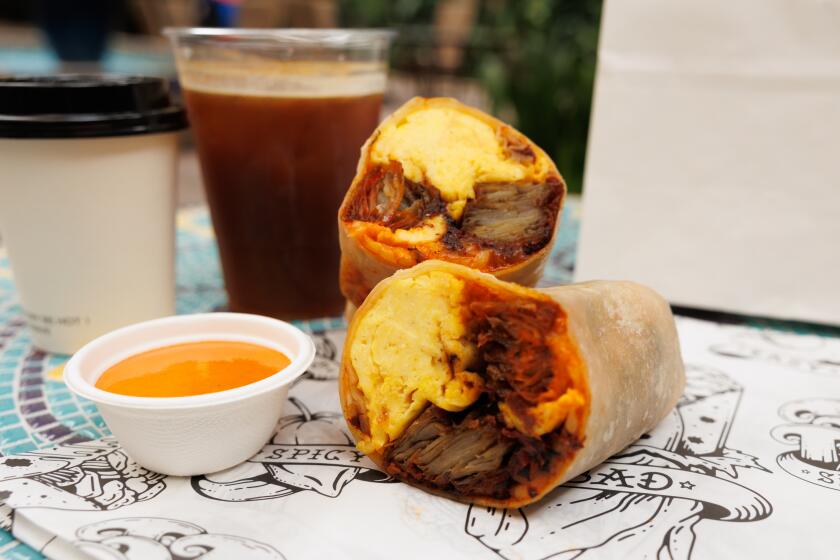Johnnycake We Hardly Know Ye
- Share via
I never meant to become embroiled in the Rhode Island johnnycake controversy. Indeed, until a recent trip to the Ocean State, I didn’t really know what a johnnycake was. I vaguely associated it with pancakes, but I had never seen one at a restaurant. I had no idea that to Rhode Islanders it is an object of civic pride and fierce debate.
A johnnycake is a small, round pancake made from Rhode Island-grown whitecap flint cornmeal. It has been a staple here since the tiny colony was founded in 1646. Johnnycake took the place of bread in Colonial times and is still widely eaten at dinner as well as at breakfast in rural parts of Rhode Island. But there all agreement ends.
The main controversy concerns the proper texture of a johnnycake. People in western Rhode Island scald the cornmeal with boiling water to make their johnnycakes thick and soft. Eastern Rhode Islanders prefer johnnycakes made with unscalded meal and fried as thin and crisp as crepes.
The debate spilled over into state politics in 1922, when representative Benjamin Boyd, from Portsmouth, tried to have his hometown version declared Rhode Island’s official johnnycake.
“Down my way we take the meal just as it comes off the stone,” Boyd explained. “We mix it with a little skim milk and a pinch of salt and we put it on the griddle so that it will run out nice and thin. We don’t scald all the pep out of it, and we never wash the griddle. We aren’t ashamed of the taste of real corn and sausage grease.”
“Over my way, we scald the meal and we wash the griddle,” retorted James T. Caswell, representative of Narragansett in western Rhode Island.
Boyd lambasted his opponent’s johnnycakes in verse:
“South County mush, South County mush, stick the coffee in it and a pig will think it slush!”
An indignant Caswell branded Boyd’s johnnycakes as “Newport County hick feed.”
The Providence Journal stepped in before the men came to fisticuffs. “When oil and water mix or when cows take unto themselves wings and fly,” concluded an editorial, “it may be that South County and Newport will agree on a common recipe for johnnycake.”
The proper thickness isn’t the only dispute surrounding the johnnycake. Rhode Islanders can’t even agree whether johnnycake should be spelled with or without an h--some experts believe the word derives from “journey cakes,” because these pocket-sized flat-cakes were popular with Colonial travelers.
The one thing Rhode Islanders do agree on is the primary ingredient: whitecap flint corn. Each ear of this unique corn has eight rows of ivory-colored kernels. The hard kernels shatter like glass when ground, which is why the corn is called “flint.” The corn grows only in Rhode Island and eastern Connecticut.
Rhode Island whitecap flint corn is a farmer’s nightmare. It blows over easily; it’s highly susceptible to disease; the naturally occurring gaps in the husks are an open invitation for insects. It is not uncommon for the whole crop to fail one out of every five years; even under the best conditions it yields only 12 tons per acre, while yellow corn yields at least 20. According to Tim McTague, co-owner of Gray’s Grist Mill in Adamsville, R.I., the difficulty of growing whitecap flint corn in Rhode Island “is like trying to build an automobile in Boston instead of Detroit.”
Gray’s Grist Mill is a low, ramshackle, peak-roofed building on the border of Rhode Island and Massachusetts. The mill has stood on this spot, across the street from a pond, since a man named Philip Tabor built it in 1717. In 18th-Century Rhode Island, every village had a grist mill like Gray’s. Today, there are only three in the state.
McTague looks very much the part of a miller. Standing six feet tall, dressed in a denim shirt and black canvas pants, he is often lightly dusted with flour from his wavy black hair to his steel-toed boots. In 1982, McTague apprenticed with the mill’s octogenarian owner, John Hart, to learn the subtleties of running a grist mill. Today he is a co-owner.
I had McTague take me to a nearby roadhouse--Ellie’s Place--where we lunched on buttery thin johnnycakes the size and shape of sand dollars. Thus began a two-day pilgrimage through the Ocean State in search of the perfect johnnycake.
I ate johnnycakes that were as crisp as cracklings and almost as skinny as playing cards. I ate johnnycakes made with scalded meal that resembled pan-fried polenta. I ate johnnycakes at greasy spoons, swank country inns, private homes and lunch counters. I ate newfangled dishes, such as johnnycakes with creamed lobster and whitecap flint cornmeal polenta, and time-honored classics such as traditional Indian pudding.
I see why the great Rhode Island johnnycake debate continues. These simple cornmeal pancakes are worth fighting over.
(Two-pound bags of johnnycake meal are available for $6.95, including postage, from Gray’s Grist Mill, Inc., P.O. Box 422, Adamsville, R.I. 02801, 508-636-6075.)
This is the simplest johnnycake. Serve it as a side dish for supper or for breakfast with maple syrup. (A purist might take exception to the syrup, but it goes well with the sweetness of the cornmeal.) Johnnycakes are quite fragile. For the best results, use a thin, wide spatula to turn them.
SIMPLE JOHNNYCAKES
2 cups johnnycake meal
3/4 teaspoon salt
3/4 cup water
1 1/2 cups milk
Butter or oil
Combine johnnycake meal and salt in bowl. Add water and whisk until mixed. Whisk in enough milk to make thin batter. (It should be consistency of crepe batter.)
Heat about 2 teaspoons butter or oil in heavy skillet over medium-high heat. Ladle batter in 2- to 3-tablespoon batches onto skillet to form 3-inch pancakes. Fry 1 minute per side or until edges are brown. Slather with butter and serve at once. Makes 20 to 24 johnnycakes.
More to Read
Eat your way across L.A.
Get our weekly Tasting Notes newsletter for reviews, news and more.
You may occasionally receive promotional content from the Los Angeles Times.










